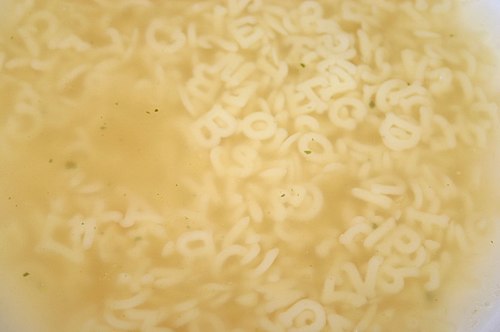 |
| So pretty! My daughter used Israeli couscous which is bigger than regular couscous. |
The first recipe she picked out is from Moosewood Restaurant in Ithaca, New York. My daughter had it this summer when we finally got to the Moosewood, after 30 years of trying on my part. It fulfills all three of her conditions. Added bonus - it's full of healthy veggies.
Moroccan Couscous Salad
(serves 4 as an entree, 6 as a side dish; total cost $7.80)
Salad
1 ½ cups dry couscous (see Note)
½ tsp salt
1 ¼ cups boiling water
1 cup diced carrots
2 large bell pepper, whatever color you like, diced
⅓ cup finely chopped red or sweet onion
1 15-16 oz can garbanzo beans (chickpeas), drained and rinsed
⅓ cup currants or raisins or craisins
½ cup sliced almonds, toasted at 300 F° for 5 minutes
Dressing
½ cup vegetable oil
juice of 1 lemon
½ tsp salt
¼ tsp ground cinnamon
3-4 tbl orange juice (juice from 1/2 an orange)
4 tbl chopped fresh parsley or cilantro (about 8 sprigs)
1 tbl fresh mint, chopped (optional)
pinch of cayenne
¼ tsp black pepper
Combine the couscous and salt in a large bowl. Add the boiling water and stir. Cover with plastic wrap and let sit for 10-15 minutes. Fluff with a fork.
While couscous is cooking, steam the diced carrots for 10 minutes. Add steamed carrots, diced peppers, onion, garbanzo beans, currants, and almonds to couscous. Stir with a fork.
Combine dressing ingredients in a medium bowl. Add to couscous mixture and mix to coat the salad.
You can eat it right away but it's even better if you chill it for an hour to let the flavors meld. It will keep for up to 4 days if refrigerated. Once it's cold, you may need to season with more salt. Cold foods don't taste as seasoned as hot foods.
Note: Couscous is a teeny-tiny pasta which doesn't require much cooking. It tends to clump together if stirred too much when hot. Fluffing with a fork keeps the grains separate.























